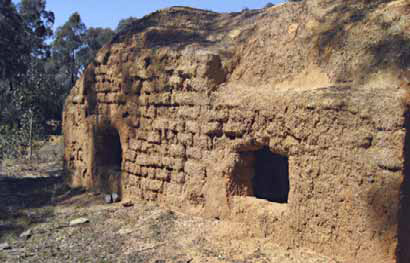Located in the bush just off Stoneham Drive, Maryborough VIC 3465. See map for exact location.



NO TREES IN MY ROOF
For centuries men have been able to meet their housing needs in ways that harmonised with their surroundings. In areas of minimum rainfall homes have traditionally been built of earth, mud brick walls supporting mud brick vaulted and domed roofs. While in forested areas timber has been the traditional construction material.
Recently however, rapid global changes have destroyed the balance between man and nature and the continual demand for timber housing, particularly in roofs, is one factor in the rapid depletion of the world's forests.
Evidence of the use of mud bricks for roofing in Iraq goes back as far as 7,500 BC. Such structures, common in the Middle East today, are structurally sound, require no timber, remain beautifully comfortable in extremes of temperature and cost almost nothing.
If these buildings could be treated to withstand rain they may prove appropriate in less arid areas. Building mud brick domes and vaults takes time. But where there is time and no money why not?
Ramesh Mananda is a Nepalese architect who is passionately concerned by the serious land degradation occurring in Nepal as a result of forest depletion. Ramesh ran a week long workshop in Maryborough on non wood roofing where the pictured domed and vaulted structure was built according to the following methods...
The following text is displayed in a document created by The Owner Builder, the Australasian Home Builders Magazine:
There is much more detailed information, including photographs of its construction and later renovation, published in the aforementioned document by The Owner Builder.
In 1982, Nepalese architect Ramesh Manandhar ran a week-long workshop with Melbourne architecture students and local sustainability enthusiasts in Central Victoria to demonstrate how mud bricks could be used in low rainfall areas to build low cost homes. This project was featured in The Owner Builder issue 5 under the title 'Not A Rafter In Sight.'
The building featured a vault and dome, constructed without timber supports, demonstrating techniques which date back over 7000 years. Using material extracted on site, and with the assistance of Maryborough Council, 50 inexperienced volunteers helped to make and lay the mud bricks over a period of several days.
Plastered with a mixture of fat, salt and lime this building was intended to be part of the Maryborough Energy Research Foundation (MERF) development, which was hindered at the time by a lack of promised funding.
The renovation
In 1978 Maryborough's innovative council had asked permaculture co-founder Bill Mollison to design them a system for their settling ponds and the proposed Maryborough Energy Research Foundation was to be part of this development.
Due to a lack of promised funding the Energy Research Foundation was forgotten about until the charming mud building was rediscovered by the newly-formed Goldfields Sustainability Group in 2011.
In November the group organised a work party and the building benefited from a two-day makeover. Led by James Henderson of Henderson Clayworks, and under the guidance of Maryborough's Terry White - who had been involved in the original construction work - the volunteers began restoration of the external plasterwork.
This work was completed in January, leaving the building with a fresh coat of plaster.

Renovation of the hut by the Goldfields Sustainability Group, 2011
(image source: http://www.livingarchitecturecentre.com/wp-content/uploads/general/OB170.pdf)